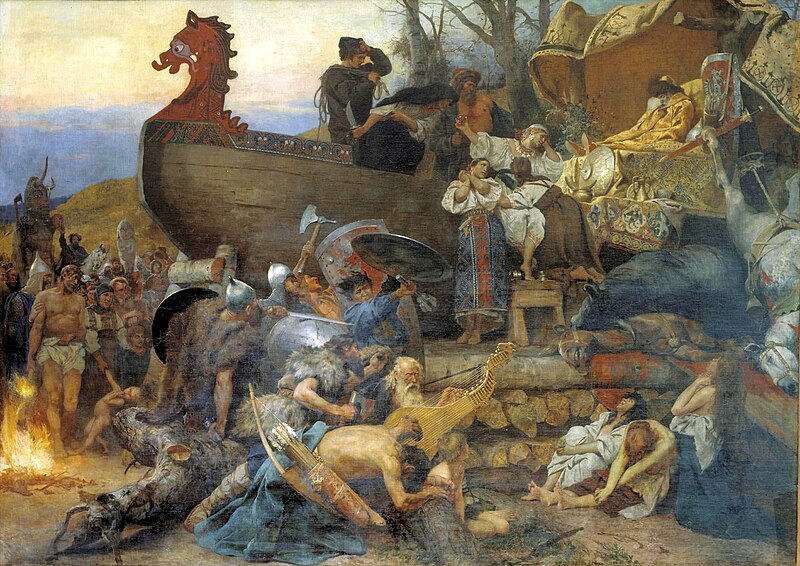In his Rihla/Risala (travel narrative, account or journal), Ibn Fadlan, who in the tenth century, accompanied a mission from the Caliph al-Muktadir to the Volga Bulgars, describes his experiences and the people and places he visited; the Khazzars, and the manners and customs of the Rus.


  Figure 2. Page of the manuscript of Ibn Fadhlan’s travel account. (Source) |
In his Rihla (travel narrative), Ibn Fadlan, who in the tenth century, accompanied a mission from the Caliph al-Muktadir to the Volga Bulgars, describes his experiences and the people and places he visited; the Khazzars, and the manners and customs of the Rus.[1]
His particular role on that journey was to read out the letter from the Caliph to the king, to present him with gifts. The Embassy had left Baghdad in June 921.[2]
The journey and the description of the various tribes encountered by the embassy are vividly described by Ibn Fadlan.[3] This is not just the earliest account in Arabic of the Volga region, it also gives the topography of the surrounding region, up to approximately 60 degree North latitude; it is also an important source of anthropology on various populations of the region.[4]
Ibn Fadlan describes very extensively the populations that live in the region, their trades, manners, clothing, diets, living, and also their customs, such as leaving a sick man alone in the tent with bread and water only, approached by none, waiting for him to either die or recover on his own. He also describes religious and other practices, such as the burning of a dead lord on a boat, and alongside him his female slaves.[5] One thing that seemed to startle Ibn Fadlan, though, was the extreme shortness of the night in those regions. He was waiting for the call for late night prayers, talking to a tailor from Baghdad for just half an hour, when he heard the call for prayers, and came out to find that it was morning.[6] And the night, he discovered, was so light that a man could be recognised by another at a distance of an arrow throw.
  |
  |
|
|
Figure 3. Front covers of four recent Arabic publications of Ibn Fadhlan’s narration of his journey to Russia. |
Figure 4. Frontispiece of the German translation of Ibn Fadhlan’s book. Edited by Ahmed Zeki Validi Togan |
Figure 5. Front cover of Ibn Fadlan’s Journey To Russia: A Tenth Century Traveler From Baghdad to the Volga River, edited by Richard N. Frye |
  Figure 6. Ibn Fadlan travels at night from Astrakhan (southern European) Russia [Scandinavia and Ibn Fadlan] |
Ahmad Ibn Fadhlan in Northern Europe: A Survey of his Account of Russian Vikings in the 10th Century


[1] For a long account of Ibn Fadlan’s travel to the Volga Bulgars, see M. Canard: Les Relations de voyage d’Ibn Fadlan chez les Bulgares de la Volga; In Annales de l’Institut d’Etudes Orientales; Vol 16; 1958; pp. 41-146; for extensive extracts on such travels see S.M. Ahmad: A History of Arab-Islamic geography; Amman; Albany; 1995 and for a summary see M. Dunlop: Arab Civilisation, to AD 1500, Longman, Librarie du Liban, 1971, pp. 169-70.
[2] M. Canard: Ibn Fadlan, in Encyclopaedia of Islam; New edition, vol 3; Brill; Leiden, 1971; – 759.
[3] S. Al-Dhhan: Risalat Ibn Fadlan; Dar Sadir; Beirut; 1993.
[4] S.M. Ahmad: A History, op cit, p. 112.
[5] Ibid, at p. 330.
[6] Ibid at p. 328.


Figure 8. Remembering Omar Sharif (On the Left) as he appeared in the 1999 film “The 13th Warrior” which tells the story of 10th-century Arab traveller Ahmed Ibn Fadlan, played by Antonio Banderas (On the Right) (Source) and here you can watch Omar Sharif’s final film “1001 Inventions and the World of Ibn Al-Haytham”, which has been dedicated to his legacy. (Source)
4 / 5. Votes 191
No votes so far! Be the first to rate this post.
Muslim Heritage:
Send us your e-mail address to be informed about our work.
This Website MuslimHeritage.com is owned by FSTC Ltd and managed by the Foundation for Science, Technology and Civilisation, UK (FSTCUK), a British charity number 1158509.
© Copyright FSTC Ltd 2002-2020. All Rights Reserved.
